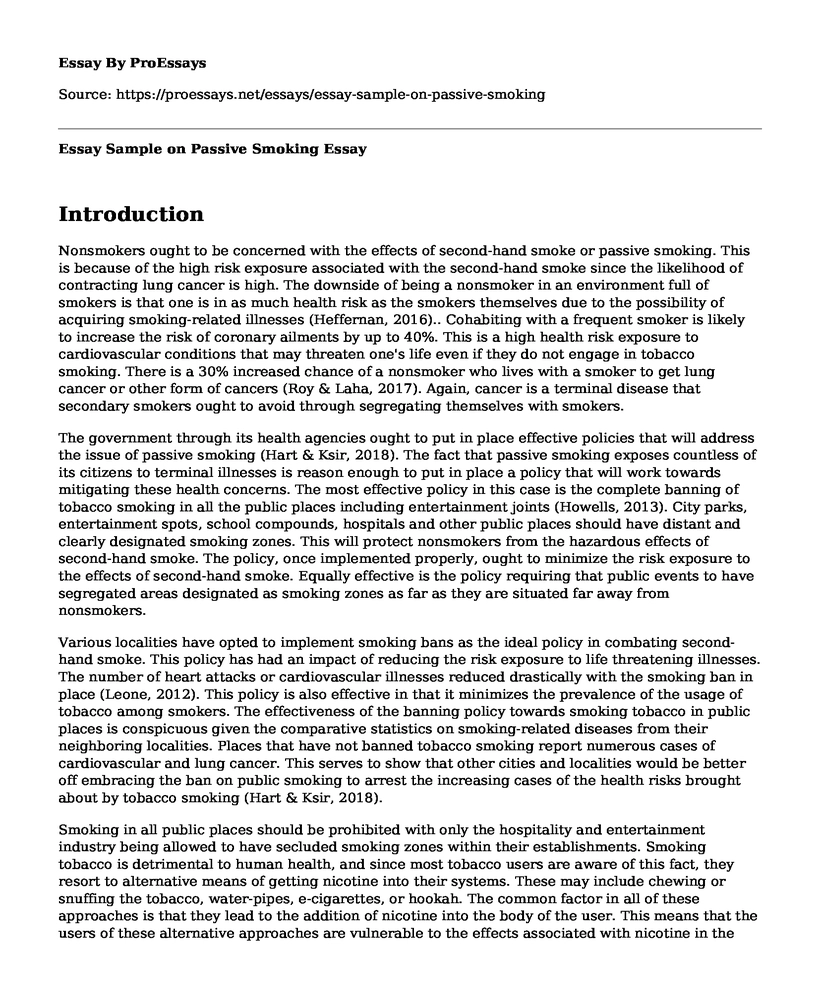Introduction
Nonsmokers ought to be concerned with the effects of second-hand smoke or passive smoking. This is because of the high risk exposure associated with the second-hand smoke since the likelihood of contracting lung cancer is high. The downside of being a nonsmoker in an environment full of smokers is that one is in as much health risk as the smokers themselves due to the possibility of acquiring smoking-related illnesses (Heffernan, 2016).. Cohabiting with a frequent smoker is likely to increase the risk of coronary ailments by up to 40%. This is a high health risk exposure to cardiovascular conditions that may threaten one's life even if they do not engage in tobacco smoking. There is a 30% increased chance of a nonsmoker who lives with a smoker to get lung cancer or other form of cancers (Roy & Laha, 2017). Again, cancer is a terminal disease that secondary smokers ought to avoid through segregating themselves with smokers.
The government through its health agencies ought to put in place effective policies that will address the issue of passive smoking (Hart & Ksir, 2018). The fact that passive smoking exposes countless of its citizens to terminal illnesses is reason enough to put in place a policy that will work towards mitigating these health concerns. The most effective policy in this case is the complete banning of tobacco smoking in all the public places including entertainment joints (Howells, 2013). City parks, entertainment spots, school compounds, hospitals and other public places should have distant and clearly designated smoking zones. This will protect nonsmokers from the hazardous effects of second-hand smoke. The policy, once implemented properly, ought to minimize the risk exposure to the effects of second-hand smoke. Equally effective is the policy requiring that public events to have segregated areas designated as smoking zones as far as they are situated far away from nonsmokers.
Various localities have opted to implement smoking bans as the ideal policy in combating second-hand smoke. This policy has had an impact of reducing the risk exposure to life threatening illnesses. The number of heart attacks or cardiovascular illnesses reduced drastically with the smoking ban in place (Leone, 2012). This policy is also effective in that it minimizes the prevalence of the usage of tobacco among smokers. The effectiveness of the banning policy towards smoking tobacco in public places is conspicuous given the comparative statistics on smoking-related diseases from their neighboring localities. Places that have not banned tobacco smoking report numerous cases of cardiovascular and lung cancer. This serves to show that other cities and localities would be better off embracing the ban on public smoking to arrest the increasing cases of the health risks brought about by tobacco smoking (Hart & Ksir, 2018).
Smoking in all public places should be prohibited with only the hospitality and entertainment industry being allowed to have secluded smoking zones within their establishments. Smoking tobacco is detrimental to human health, and since most tobacco users are aware of this fact, they resort to alternative means of getting nicotine into their systems. These may include chewing or snuffing the tobacco, water-pipes, e-cigarettes, or hookah. The common factor in all of these approaches is that they lead to the addition of nicotine into the body of the user. This means that the users of these alternative approaches are vulnerable to the effects associated with nicotine in the human body. Despite the common belief that these alternative means are less hazardous than smoking cigarettes, the reality remains that they have an almost similar effect in terms of the health consequences to the body.
References
Hart, C. L., & Ksir, C. (2018). Drugs, society & human behavior. New York, NY: McGraw-Hill Education.
Heffernan, T. (2016). The Impact of active and passive smoking upon health and neurocognitive function. Frontiers Media SA
Howells, G. (2013). The tobacco challenge: Legal policy and consumer protection. Ashgate Publishing Ltd.
Leone, A. (2012). Passive smoking and cardiovascular pathology. Hauppauge, N.Y: Nova Science.
Roy, P., & Laha, A. K. (2017). Understanding lung cancer: Tobacco smoking linkage. London: SAGE Publications Ltd.
Cite this page
Essay Sample on Passive Smoking. (2022, Jun 23). Retrieved from https://proessays.net/essays/essay-sample-on-passive-smoking
If you are the original author of this essay and no longer wish to have it published on the ProEssays website, please click below to request its removal:
- Economic Discussions on Artistic Roles
- The Obesity Epidemic in America Paper Example
- Essay Sample on Texas Hospitals Tackle Opioid Abuse Crisis in Emergency Departments
- Essay Sample on Elderly Security: CCTV in Care Homes
- Research Paper on Intersectionality: Examining Multivariate Power Factors for Equal Health Outcomes
- Essay Sample on Ban Conversion Therapy: LGBTQ People Should Not Be Forced To Change
- Esaay Exploring Nursing Theories and Contributions: From Nightingale to Peplau







